Counterfeit wardrobe tools
It turns out we’re not after *the* tool, we’re after our version of the tool.
About 18 months ago, I started noticing a gap in my wardrobe.
Another rainy Sunday on the soccer sidelines, and I was asking myself: what pants can I wear that won’t trail in the mud? And when I wanted to throw on an oversized blazer or coat: which bottoms are slim enough that I don’t get swallowed by all the volume? You get the gist.
My frustration suggested a genuine wardrobe gap.
From there, it wasn’t hard to narrow down the tool I needed. Some slim to balance the volume. Some denim for versatility and durability. Voilà: slim jeans.
The new language of wardrobe tools shifts our focus to functionality—what clothes do. The balloon skirt brings drama. The weird shoe adds irony. The dressy bag introduces friction to a casual outfit. Slim jeans? They’re a tool that delivers the slim (not a must-have dictated by the fashion cycle).
But there’s a snag with this new language of tools: it implies universal functions. A hammer might work the same for everyone—clothes do not. In your edgy wardrobe, my balloon skirt brings no drama. In your quirky wardrobe, my weird shoe adds zero irony. In your glam wardrobe, my dressy bag delivers no friction. And the kicker? One person’s go-to tool is another person’s neverworn.
Design practice can help make sense of this.
As architects, we take basic functional principles—say, for a bathroom—and tailor them to the needs and quirks of real people. A client might want a bench for their partner to perch on while they take a bath, or extra-deep cupboards for an out-sized towel collection. Same functional backbone, but tuned to the lives that will actually unfold there. For the rest of us living in homes not designed specially for us, we come to know the friction of generic functionality: it sparks that inevitable mental list of if only they’d just done x, y, z’s…
Wardrobe tools are no different. We might all crave similar, generic functionality—the slim, the drama, the friction—but the form that takes is personal, informed by our own style, our bodies, our lifestyles, and our budgets.
It turns out we’re not after the tool, we’re after our version of the tool.
And as I learnt over the past 18 months, that subtle difference can be quite the mindfuck. Identifying my version of the bring-the-slim tool was surprisingly tricky.
Here’s what the hunt taught me about finding my version of the tool (MVoTT), plus my cheat-sheet for spotting generic tools—and avoiding the counterfeit tools—along the way.
Slim pickings & counterfeit tools
About 18 months ago, I started looking for a pair of slim jeans.
At the time, the slimmest jeans I owned were these vintage Levi’s. I was after something a little less casual, a little less obviously worn to death.
So began the search.
Jean shopping is a near-universal sucky experience—so I readied myself for battle.

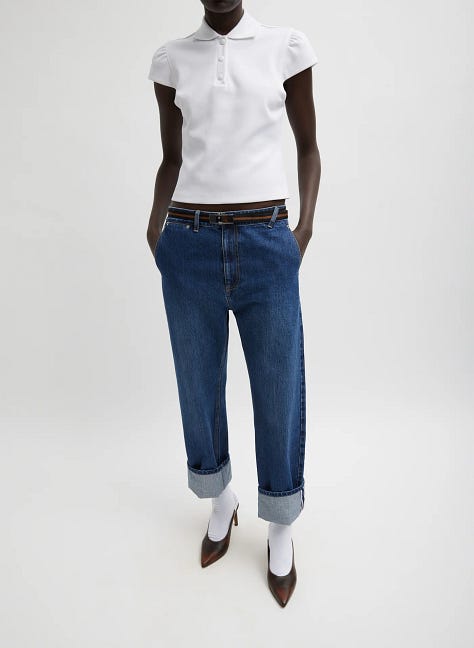
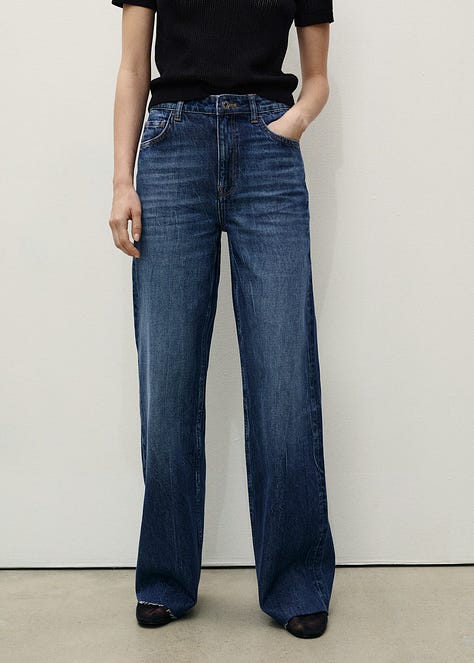
Among them, the 2024 Tibi Alec jeans. Despite the name, they were more trouser than jean, and an absolute no-go on my pear-ish frame. The Aussie Henne Valentina jeans were flattering but uncomfortable, plus I didn’t love the blue wash. I tried the black too but returned them—I wanted jeans I’d reach for, even when working from home, not jeans I’m desperate to rip off my body. Mango’s Danila and Cos’ column jeans were in the mix too—both offered reliable fits, no splurge required.
None felt good. None felt like me. The search went on.
The closest pair I came to buying were the Citizens of Humanity Baretta Relaxed Straight jeans in Babylonia. The color was perfection—classic vintage blue with no weird undertones—and the denim was comfy. The length was a tiny bit awkward: perfect for cuffing or sandals, but too short to puddle with boots or sneakers. But from the back, they gave me saggy diaper-butt. I considered tailoring, but the weird length stopped me. When they later popped up on mega-sale, I reminded myself that those little quirks I convinced myself I could work around would be exactly why they’d end up in the cull pile later.
A pair of jeans can tick a lot of boxes and still be a bad idea.
It had me reflecting on a stage a few years back. I was floundering around with my style, and inexplicably wedded to the Agolde 90s Pinch Waist jeans. These jeans that looked fab on others, always had me feeling pretty blah.
Wearying of the search at this point, I had to ask myself if I was really on the hunt for a pair of jeans that would make me feel oh-so-ordinary again?
It turns out, there are lot of things qualify as a bring-the-slim tool, but very few of these qualify as my version of the bring the slim tool.
Hence the predictable no-gos and all the almost-but-not-quite-rights.
Beware these counterfeit tools.
It’s easy to blame yourself when you’re flailing like this. Was it my lack of dedication to this hunt? Surely, I thought, everyone has a trusty pair of slim jeans. How had I reached this lovely middle age without identifying my go-to brand?
I tried to reassure myself that I was not alone. I watched self-professed-non-jean-person Irene Kim’s (In Moda Veritas) fabulous Great Jean Search of 2025 with awe and hope. Her rec for the Veronica Beard Ryder sounded fab, but I’m over-indexed on the barrel already.
Still empty handed in late 2024, it was starting to look like this wasn’t a tool for me.
My version of the tool (MVoTT)
And then Tibi released the Alex Jeans.* A generous account might argue I played the long game and came up trumps. Either way, my hunt ended well.
I ordered a pair off Shopbop. They fit, but looked decidedly average. I sized up—hoping for something better—but the difference was imperceptible. Back they went too.
Then I saw Amy Smilovic wearing these jeans, they were loose and low slung. I decided to size up again. The 27s were it. That very evening I threw them on as I headed out—always a promising sign. Since then, they’ve been on repeat through the tail end of Melbourne’s winter: out, to work, chilling on the weekend, even as all-day WFH pants.
They’ve slid neatly into my life.
To some, these jeans won’t look remotely slim. But for me, these jeans bring the slim—they’re perfect for the moments when my narrow trousers and slim skirts don’t quite work, and my Levis feel too casual.
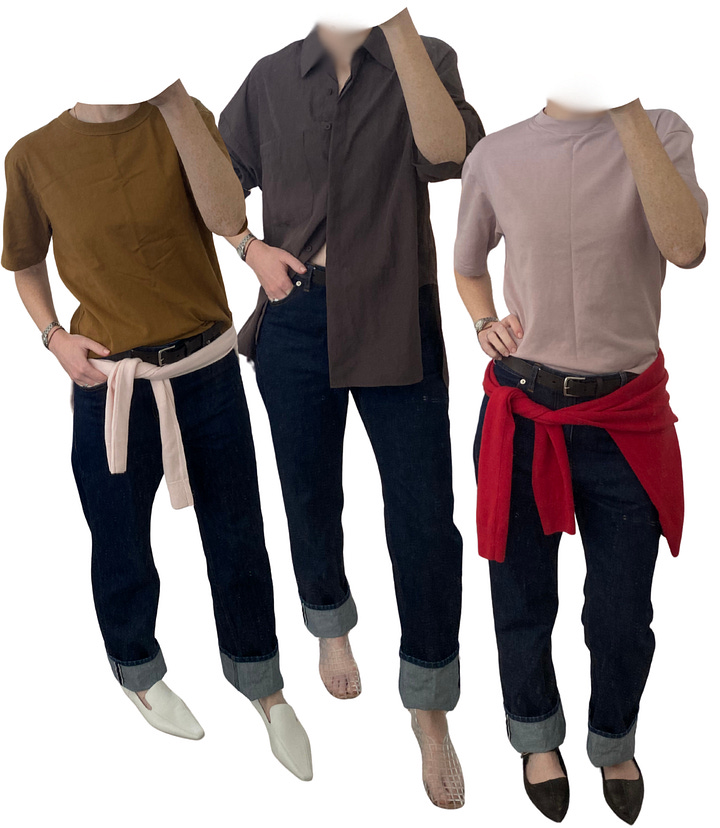
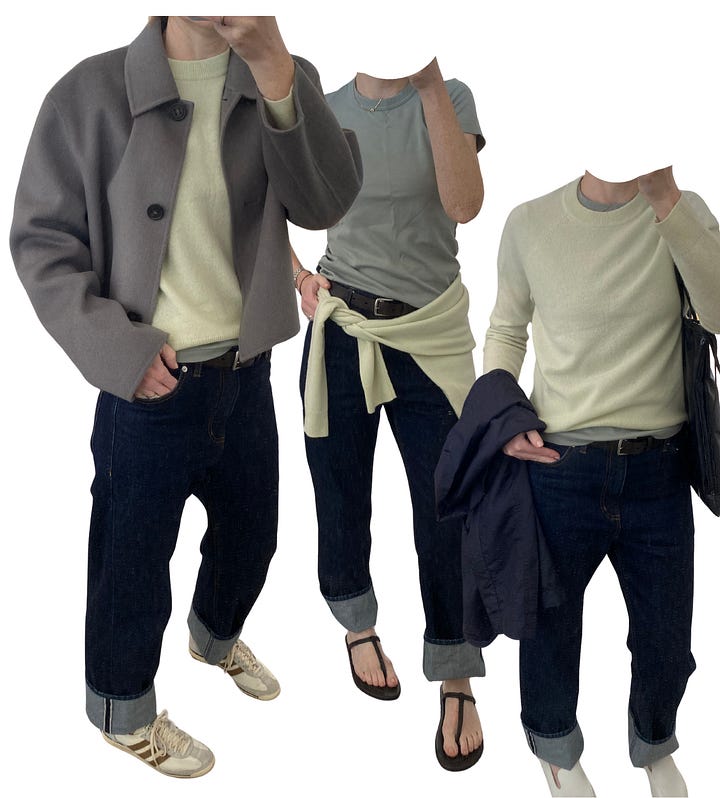
*There’s no quality difference between these and any trusty pair denim brand to justify the silly price tag. In a previous life, I could buy several less expensive pairs, hope for the best, then watch them languish in the wardrobe. There’s merit in the just-buy-the-thing philosophy, if the alternative is 37 slightly-off versions that never quite hit right.
Your version of the tool
Wardrobe tools serve a specific function. They do something to an outfit.
It sounds so simple, but identifying my version of the bring-the-slim tool turned out to be surprisingly tricky.
Maybe it’s obvious why. For starters, you could argue what the pair I landed on don’t even qualify as slim. But that’s the point really; my version of slim is defined relative to my personal quirks and needs, including the relative size of my other bottoms.
So here’s 7 principles—a cheat sheet, if you will—that I’ll be referring to next time I’m after a specific tool.
1. We don’t need all the tools.
We’re not talking collectibles; we don’t need to ‘complete the set’, so to speak.
A wardrobe packed with all the tools risks more scrambing and less clarity. Unless you’re a styling savant, in which case keep collecting.
2. Some tools aren’t for us.
We need to pick tools that serve us.
To labour the analogy, the carpenter doesn’t want his ute (truck) filled with glass-blowing tools.
Sometimes the gaps in our wardrobes are intentional, strategic even and they help give shape to our distinctly personal style.
Don’t acquire tools to fill gaps that don’t need filling.
3. Avoid token tools
‘She’ll do’ is an ill-advised acquisition strategy for our wardrobes.
Hindsight’s golden, but I’m relieved I didn’t settle.
One good beats five almosts. And I know I don’t want a wardrobe built from almost-right pieces that mount up to create nothing-works-today stress.
Play the long game. Reap the benefits.
Leaving the search on pause/hiatus—for some indefinite time—sucks. We want to check that box and move on with living.
But we also probably know deep down that the best wardrobes don’t come from profligate spending and culling cycles, but rather from thoughtful, disciplined buys and edits.
4. Beware the counterfeit tool
No one wants a dodgy tool.
But here’s the thing, we’re the only one’s capable of discerning the dodgy tool from the powerful tool. We’re the only ones who know—who feel—the tool working or flailing.
If I’d bought any of the jeans that passed through my dressing room these past 18 months, they’d be sitting largely unworn, making me feel flat, and likely heading for resale sometime soon. This I know: don’t expect much from a dodgy tool.
5. My tool doesn’t look like your tool, and that’s a-ok.
The right tool for us isn’t generic; it’s tailored to us.
These not so slim jeans are my version of the slim tool. They won’t be everyone’s by any stretch.
In other areas of life, we’re comfortable with our-version-of-the-thing. My mac-n-cheese is a three-ingredient go-to; my girls claim to love. It’s not my mother-in-law’s genius recipe, which is on-another-planet delicious. No worries, we’re working under very different time constraints and levels of chefing prowess.
The right tool for me, is the tool that serves me—right here, right now, with this body and my lifestyle.
6. Back your winner
A new tool means new styling options we didn’t have before.
Put her to use: break the seal asap, if weather/lifestyle/stars align.
Back your winner. Lower your cost per wear.
7. Careful dallying with duplicates.
You’ve just bought the thing, you love it. Maybe it’s even better than you imagined.
The next logical step isn’t another iteration of the thing, however tempting.
Stay faithful.
Between my trusty old Levis and these new Indigo straight legs, I’m more than covered knowing slim pants are not my go-to.
There’s no duplicate right now that offers me more than it risks by adding clutter, stalling cost-per-wear, diluting the joy of the original, distracting me from exploring other tools, and eating up my budget.
Design practice reminds us that addressing generic functions isn’t enough; the magic comes when functional requirements get tailored to real people. It seems wardrobe tools work much the same way.
Hello—I’m pretty new around here. If you like what you see, please subscribe and restack to support my little design studio. I’d be so thrilled. Thank you :) — architect Meg.
The phantom wardrobe gap
The road to building a wardrobe that works is stricken with potholes, diversions, and about-turns. This week I found myself veering off course.
Is this piece too bossy?
I saw a great post from Rose @Creative Classicist (from the other app) yesterday that got me thinking.
The Shape of Us
Hello—I’m brand new around here. If you like what you see, please subscribe and restack to support my little design studio. I’d be so thrilled. Thank you :) — architect Meg.
Modern, minimal, Australian: Three recent picks
Welcome—I’m brand new around here. If you like what you read, please subscribe and restack to support my little design studio. I’d be so thrilled. Thank you :) — architect Meg.



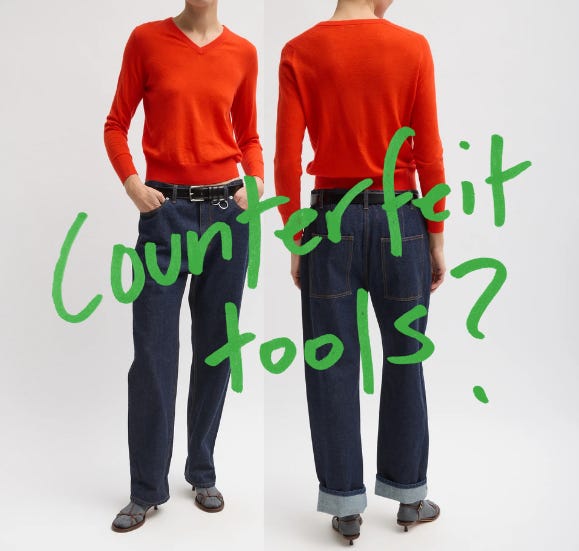
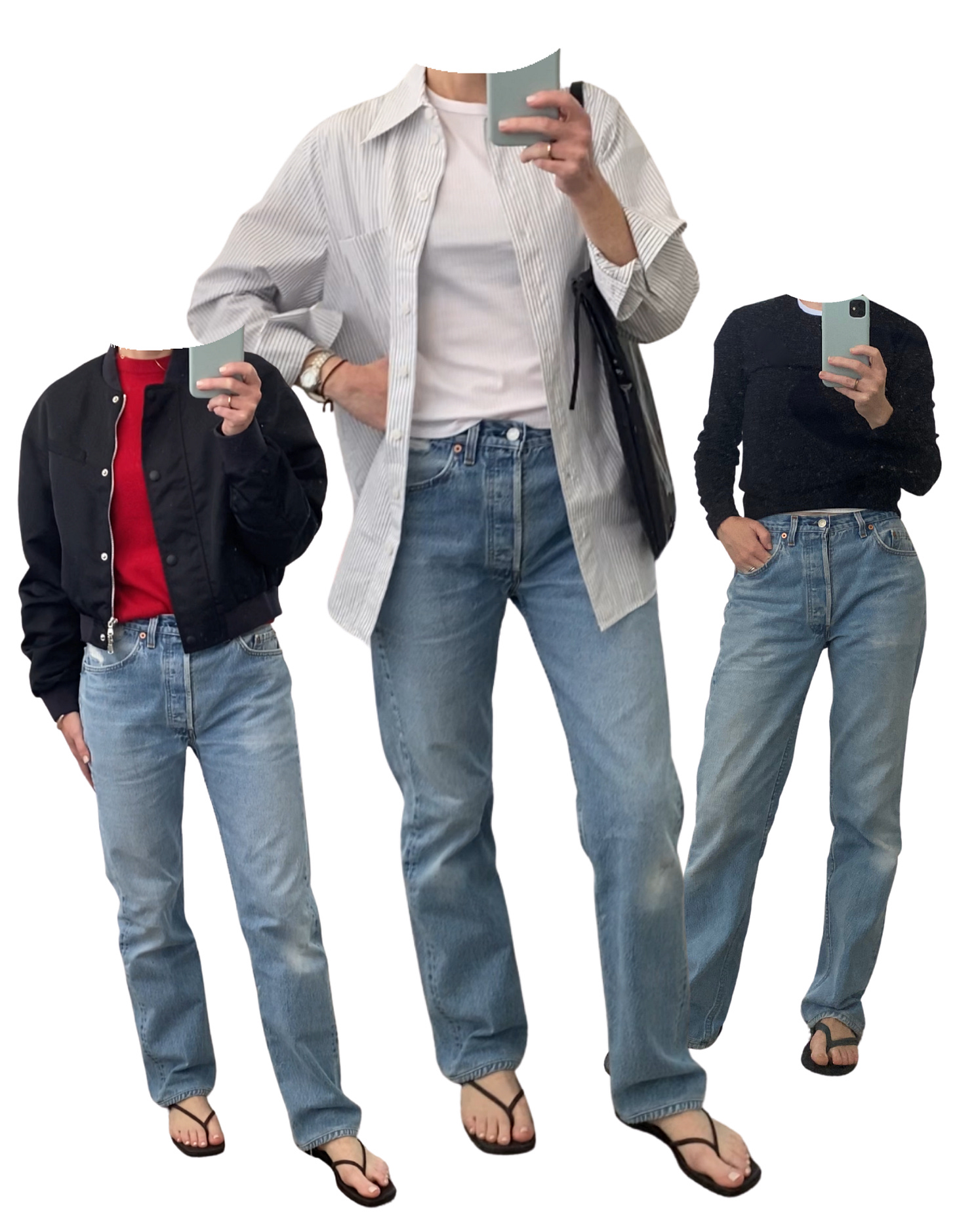
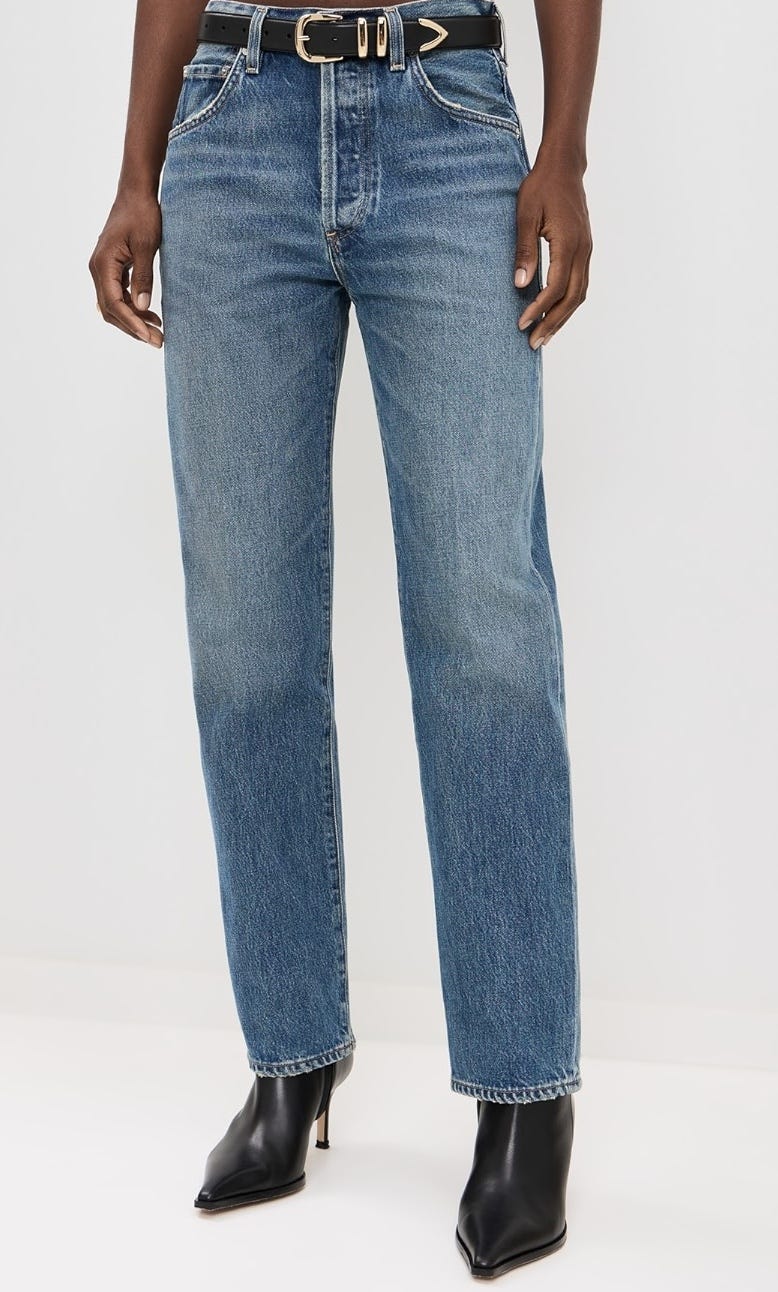


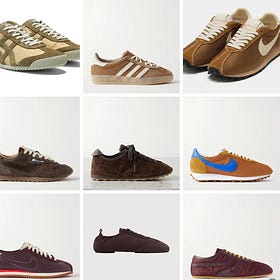


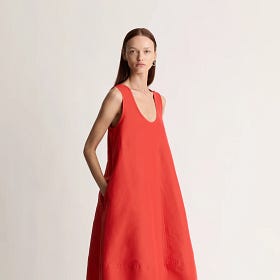
I love this idea of finding your tool and then sticking to that instead of buying multiples!